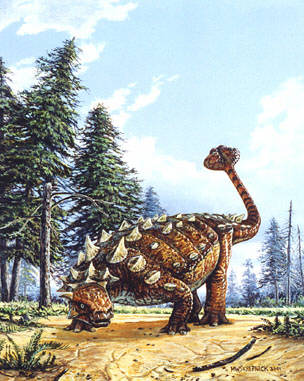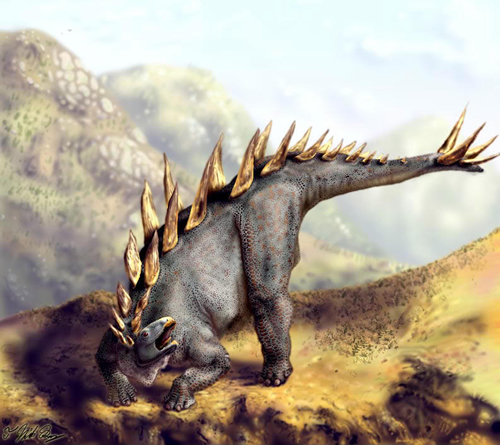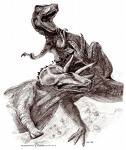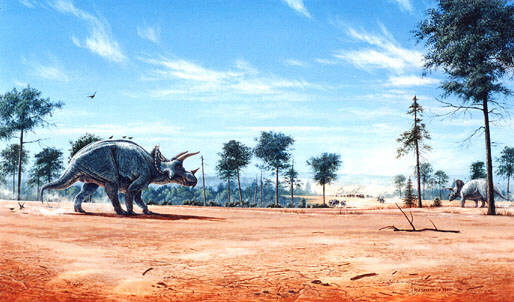Built for Defense
Homepage > Dinosaur Anatomy - Built
for Defense
The primary concern for herbivore dinosaurs was to get enough to eat. The second concern would be to stay alive around enormous carnivores that lived during their time. A herbivore dinosaur would have spent most of its time eating. Since most of these sauropods were large in size, they needed to eat a lot of vegetation to stay alive. Some of these sauropods, such as Sauroposeidon will consume as much as a ton a day.
When it came time to defend against predators, many herbivores were equipped with horns, claws, spikes, and some of them had armor around their bodies. Others were naturally protected by their sheer size. Many of these herbivores were herd animals, the same way wildebeests and antelope are today. The herd would have offered some protection to these dinosaurs in numbers. The herd would also allow for some of these dinosaurs to feed while others kept an eye out for predators.
Armor Plates
 Euoplocephalus
was one of the best armored dinosaurs. It had a short and stocky body.
This ankylosaur's back and sides were covered in a dense protective layer
of bony plates.
Euoplocephalus
was one of the best armored dinosaurs. It had a short and stocky body.
This ankylosaur's back and sides were covered in a dense protective layer
of bony plates.
Euoplocephalus had a solid, heavily reinforced club at the end of its tail. This club might have been wielded like a knight's mace. It would have been a powerful weapon when used against its opponents. It could crush the legs or ribs of an attacker, leaving them with possible massive internal injuries.
Euoplocephalus had thick spines along its back and on the side of its face for protection. Even its eyelids were armored. This dinosaur was built like a tank, very well protected all around, except for its underbelly. Its underbelly was soft and not as heavily protected as the rest of its body. To turn this dinosaur over, a predator had to brave a deadly counter attack from this dinosaur's solid club.
Spiny Tails
Tuojiangosaurus is known from a nearly complete skeleton. Tuojiangosaurus had a typical stegosaur skull with an elongated face and spoon-shape teeth. This dinosaur had two rows of triangular plates that spread along the dinosaur's back. These 15 pairs of bony back plates might have offered some protection to the dinosaur. These plates were positioned on its neck, over its shoulders, and all the way down to the middle of its tail.
At the end of its tail this dinosaur displayed four defensive spikes. It is believed that Tuojiangosaurus may have used this spikes to ward off predators that were trying to attack the dinosaur. He may have confronted the predator in a sideways manner, swinging its tail and making its spikes noticed.

Horns
 Triceratops
may have been one of the toughest rivals for large theropods such as Tyrannosaurus
rex. This large herbivore was 26 feet in length and could weigh as much
as 6 tons. Triceratops was half as tall as Tyrannosaurus rex, yet weighed
about the same.
Triceratops
may have been one of the toughest rivals for large theropods such as Tyrannosaurus
rex. This large herbivore was 26 feet in length and could weigh as much
as 6 tons. Triceratops was half as tall as Tyrannosaurus rex, yet weighed
about the same.  The
difference is how Triceratops distributed its weight, its back legs were
straight and its front legs spread out like a lizard. With this design,
most of Triceratops' weight would be distributed to its head, which weighed
about 1,000 pounds. When Triceratops charged an attack, it would dig in
to the predators flesh, and its rival was going no where. Triceratops
was designed like a bulldozer . Its bony frill protected Triceratops'
soft body, which was vulnerable for an attack.
The
difference is how Triceratops distributed its weight, its back legs were
straight and its front legs spread out like a lizard. With this design,
most of Triceratops' weight would be distributed to its head, which weighed
about 1,000 pounds. When Triceratops charged an attack, it would dig in
to the predators flesh, and its rival was going no where. Triceratops
was designed like a bulldozer . Its bony frill protected Triceratops'
soft body, which was vulnerable for an attack.
Its frill was solid bone, 6 times thicker than a human skull. Triceratops' frill would create an almost impenetrable shield. Its horns were 4 feet in length. These horns were long enough to have reached a Tyrannosaurus rex's heart. These horns were made of solid bone grown directly out of its skull. There's no other known animal to have grown horns in this manner.

Image coutesy of Michael Skrepnick
These horns were a foot wide at the base and were able to withstand up to 36,000 pounds of force. This is enough force to go thru the body of a car. Triceratops was one of the most successful herbivores to live during the dinosaur era. This is why a predator would think twice before attacking. Triceratops possessed a ball and socket joint at the base of its skull. This would have allowed it to maneuver its head almost 360 degrees. This joint allowed movement in any direction in a fraction of a second, enabling Triceratops to position its head between its body and the predator. This head maneuverability is not found in any dinosaur or any mammal today.